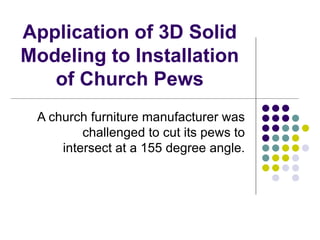3D drawings aid mitering
- 1. Application of 3D Solid Modeling to Installation of Church Pews A church furniture manufacturer was challenged to cut its pews to intersect at a 155 degree angle.
- 4. The Situation: Personnel must cut seats, backs, and back rails at compound angles as separate parts so that they could be assembled correctly in the field. Engineering needed to provide simple drawings to communicate orientation of parts and cutting angles for miter saws to shop personnel.
- 5. Action #1: I created a 3D solid model of the pew and âslicedâ it at a 155° angle.
- 6. Plan View of the Pew
- 7. Action #2: I selectively activated drawing layers, changed coordinate systems, added dimensions and angles, and printed drawings of each part.
- 8. The back was laid on the saw table and cut at a 3° angle but the blade had to be tiltedâĶ
- 9. at an angle of 12° to the table of the saw.
- 10. The back cap had to be cut at a 12° angle but the saw blade had to be tiltedâĶ
- 11. at an angle of 3° to the table of the saw.
- 12. The seat bottom had to be cut at almost 12.5° but the blade must be tiltedâĶ
- 13. at an angle of 88.5° degrees to the table of the saw.
- 14. Results: Installation time was reduced because installers did not have to re-cut parts in the field. Re-work was reduced at the factory because parts were not sent back to be remanufactured. Customer satisfaction increased due to higher quality appearance and faster installations.
- 15. Completed in February, 2004 by: Stephen C. Martin (615) 669-9363 http://www.linkedin.com/in/stephenclydemartin














